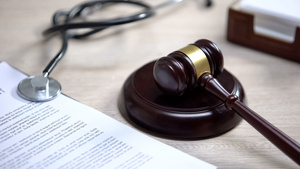 Undergoing surgery requires placing complete trust in medical professionals with your health and wellbeing. When that trust is broken by a surgical error, the consequences can be devastating – leading to additional medical procedures, extended recovery periods, permanent disability, or even loss of life. Patients who suffer harm due to surgical mistakes often face not only physical and emotional challenges but also financial burdens from additional medical care.
Undergoing surgery requires placing complete trust in medical professionals with your health and wellbeing. When that trust is broken by a surgical error, the consequences can be devastating – leading to additional medical procedures, extended recovery periods, permanent disability, or even loss of life. Patients who suffer harm due to surgical mistakes often face not only physical and emotional challenges but also financial burdens from additional medical care.
If you believe you or a loved one has been harmed by a surgical error, understanding the evidence required to prove medical negligence is crucial to pursuing justice. Building a successful medical malpractice case requires specific types of evidence that establish both that an error occurred and that it directly caused your injuries.
Medical Records: The Foundation of Your Case
Medical records form the cornerstone of any surgical error claim. These documents provide a chronological account of your treatment, including:
- Pre-surgical consultations and evaluations
- Surgical consent forms
- Operation reports detailing the procedure
- Anesthesia records
- Post-operative notes and instructions
- Nursing notes documenting your care and recovery
- Medication administration records
- Subsequent treatment records addressing complications
Complete and unaltered medical records are essential, as they may reveal inconsistencies, omissions, or documentation of unexpected outcomes. Your attorney will work with medical experts to analyze these records and identify where standards of care were not met.
Expert Medical Testimony
Perhaps the most critical element in proving a surgical error is expert testimony from qualified medical professionals. Pennsylvania law typically requires expert witnesses who:
- Practice in the same specialty as the defendant surgeon
- Are familiar with the standard of care for the procedure in question
- Can testify to how the surgeon deviated from accepted standards
- Can establish how that deviation caused the patient’s injuries
Expert witnesses review all available evidence and provide professional opinions on whether the surgical error constitutes negligence. Their testimony helps bridge the knowledge gap for judges and jurors who lack medical expertise to evaluate technical aspects of your case.
Evidence of the Standard of Care
To prove negligence, you must establish what the appropriate standard of care was for your particular surgical procedure. Evidence may include:
- Medical literature and peer-reviewed journal articles
- Professional practice guidelines from medical associations
- Hospital protocols and policies
- Medical textbooks and reference materials
- Testimony about customary practices in the community
This evidence creates a benchmark against which the surgeon’s actions can be measured, demonstrating what a reasonably competent surgeon would have done under similar circumstances.
Documentation of Deviation from Standards
Once the standard of care is established, evidence must show how the surgeon deviated from these standards. This might include:
- Operative notes indicating unexpected complications
- Documentation of incorrect procedures performed
- Evidence of wrong-site surgery
- Records showing retained surgical instruments or materials
- Anesthesia errors documented in medical records
- Proof of inadequate pre-operative planning
- Evidence of improper technique or approach
In some cases, subsequent treating physicians may note their observations of surgical errors in your medical records, providing valuable contemporaneous evidence of deviations.
Causation Evidence
Proving that the surgical error directly caused your injuries is often the most challenging aspect of a medical malpractice case. Evidence establishing causation may include:
- Medical records documenting the onset of complications immediately following surgery
- Diagnostic imaging showing the physical evidence of error (such as retained surgical instruments)
- Laboratory results indicating infection or other complications
- Testimony from treating physicians about the relationship between the error and your outcome
- Expert analysis explaining the medical mechanism of injury
Without evidence of causation, even a clear surgical error may not result in a successful claim if the harm cannot be directly attributed to the mistake.
Damages Documentation
Finally, evidence must quantify the damages resulting from the surgical error:
- Medical bills from additional procedures and treatments
- Pharmacy records for pain medications and other prescriptions
- Employment records showing lost wages and diminished earning capacity
- Physical therapy and rehabilitation records
- Mental health treatment records for emotional distress
- Testimony from life care planners about future medical needs
- Photographic evidence of physical injuries
- Personal journals documenting pain and recovery
Navigating the Complexities of Surgical Error Claims
The attorneys at Rubin, Glickman, Steinberg & Gifford, P.C. understand the detailed evidence needed to build a compelling surgical error case. With extensive experience in medical malpractice litigation throughout Montgomery and Bucks counties, our legal team works with trusted medical experts to analyze your case and identify all instances of negligence.
If you believe you or a family member has suffered due to a surgical error, contact our office at (215) 822-7575 or through our online contact form to schedule a consultation. We can help you gather the crucial evidence needed to prove your case and pursue the compensation you deserve for your injuries.

Rubin, Glickman, Steinberg & Gifford P.C.
Pennsylvania Attorney's
August 12, 2025









